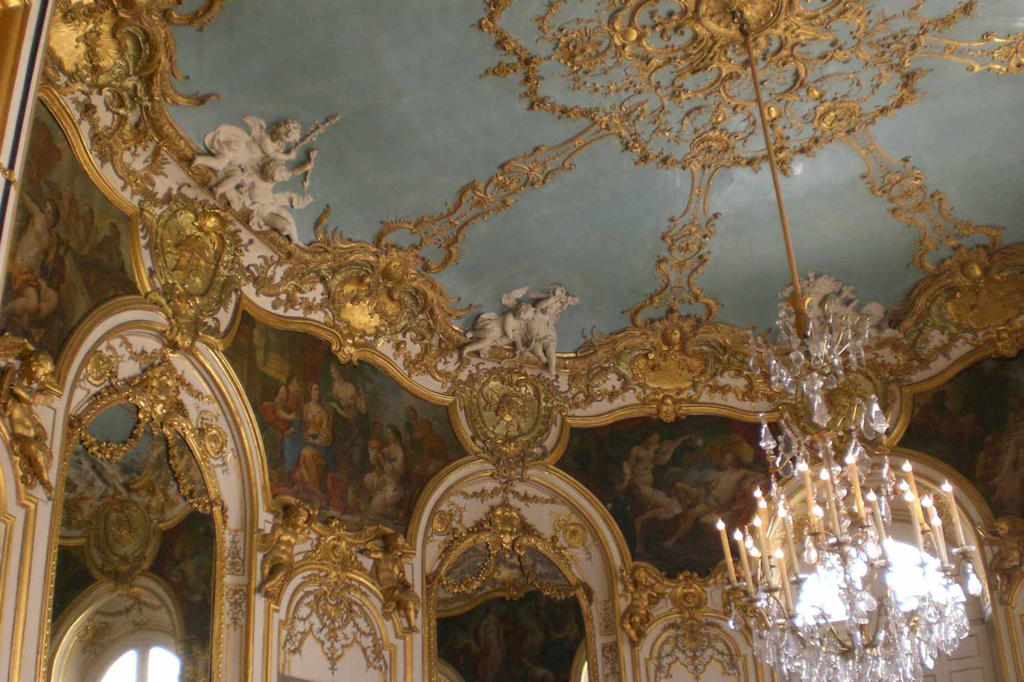Key Characteristics of Rococo Art and Architecture:
- Ornamentation and Curvilinear Forms: Rococo art and architecture are characterized by an abundance of decorative elements and intricate ornamentation. Elaborate scrollwork, delicate floral motifs, and whimsical curves adorn surfaces, creating a sense of lightness and playfulness. The use of asymmetrical designs and flowing lines adds a dynamic and fluid quality to Rococo compositions.
- Pastel Colors and Soft Lighting: Rococo embraces a palette of soft pastel colors, including shades of pink, blue, and cream, which contribute to the delicate and ethereal atmosphere. The interplay of light and shadow, often achieved through the use of natural light and strategically placed mirrors, enhances the overall effect, creating a sense of enchantment and charm.
- Themes of Love, Nature, and Frivolity: Rococo art often depicted scenes of love, flirtation, and leisurely pursuits. It celebrated the pleasures of life, capturing the essence of aristocratic society during the period. Nature, particularly garden settings and pastoral landscapes, was a popular theme, reflecting a desire to escape into idyllic realms of beauty and tranquility.
- Exquisite Craftsmanship and Attention to Detail: Rococo artists and craftsmen paid meticulous attention to detail, employing intricate techniques such as delicate stucco work, gilding, and marquetry. Furniture, decorative objects, and interiors were meticulously crafted, reflecting the pursuit of refined luxury and elegance.
Notable Artists of the Rococo Period:
- François Boucher (1703-1770): François Boucher, a prominent French painter, is known for his sensual and mythological subject matter. His paintings exude a sense of frivolity and romance, often featuring delicate pastel colors, fluid brushwork, and scenes of pastoral beauty.
- Jean-Antoine Watteau (1684-1721): Jean-Antoine Watteau, a French Rococo painter, is renowned for his elegant and poetic portrayals of aristocratic life. His artworks, characterized by soft lighting, ethereal figures, and landscapes, capture a sense of grace and melancholy.
- Giovanni Battista Tiepolo (1696-1770): Giovanni Battista Tiepolo, an Italian Rococo painter, is celebrated for his grand frescoes and ceiling paintings. His works showcase a mastery of illusionistic techniques, vibrant colors, and dynamic compositions, depicting mythological, historical, and religious themes.
- Germain Boffrand (1667-1754): Germain Boffrand, a French architect and interior designer, played a pivotal role in shaping Rococo architecture. His designs featured ornate stucco work, elegant curves, and intricate detailing, transforming spaces into sumptuous and enchanting settings.
Lisbon.vip Recommends
Notable Examples of Rococo Art and Architecture in Portugal:
- Queluz National Palace: The Queluz National Palace, located in Queluz near Lisbon, is a stunning example of Rococo architecture in Portugal. Built in the 18th century, the palace combines elements of Baroque, Rococo, and Neoclassical styles. Its facades feature delicate ornamentation, intricate stonework, and charming balconies. The interiors are adorned with exquisite frescoes, elegant stuccowork, and opulent chandeliers.
- Ajuda National Palace: Situated in Lisbon, the Ajuda National Palace is another remarkable showcase of Rococo and Neoclassical architecture. Constructed in the late 18th century, it exhibits a harmonious blend of styles. The palace's grand entrance hall, known as the Hall of Ambassadors, features elaborate stuccowork and decorative motifs, while the Queen's Apartments display elegant Rococo interiors with gilded details and ornate ceilings.
- Mafra National Palace: The Mafra National Palace, located in the town of Mafra, showcases a fusion of Baroque and Rococo architecture. Built in the late 18th century, the palace is renowned for its imposing facade and monumental size. The interior spaces, particularly the Rococo-style Library and Basilica, feature exquisite marble work, intricate woodcarvings, and ornate decorative elements.
- Viana do Castelo City Hall: The Viana do Castelo City Hall, situated in the city of Viana do Castelo, exemplifies Rococo architecture in northern Portugal. Dating back to the 18th century, it showcases a charming facade adorned with Rococo-style ornamentation, including decorative balconies, intricate ironwork, and delicate stonework. The interior features elegant halls and rooms with elaborate ceilings and decorative elements.
- Évora Cathedral (Sé de Évora): The Évora Cathedral, located in the city of Évora, incorporates Rococo elements into its predominantly Gothic structure. Built over several centuries, the cathedral's facade displays a blend of architectural styles, with Rococo influences evident in the decorative details, such as the intricate sculptures and ornamental motifs.
Enduring Influence and Legacy:
The Rococo period, with its emphasis on elegance, intricate ornamentation, and lighthearted themes, left a lasting impact on art, architecture, and decorative arts. Its influence can be seen in the development of Neoclassicism and later design movements such as Art Nouveau. The delicate curves, playful motifs, and attention to detail continue to inspire contemporary designers and craftsmen, adding a touch of whimsy and refinement to modern aesthetics.The Rococo period stands as a testament to the pursuit of elegance, charm, and frivolity during the 18th century. Through its ornate decoration, pastel colors, and celebration of love and nature, Rococo art and architecture transport us to a world of enchantment and refined luxury. The exquisite craftsmanship and attention to detail showcased by Rococo artists and artisans continue to captivate audiences, leaving an indelible mark on the history of art and design.



